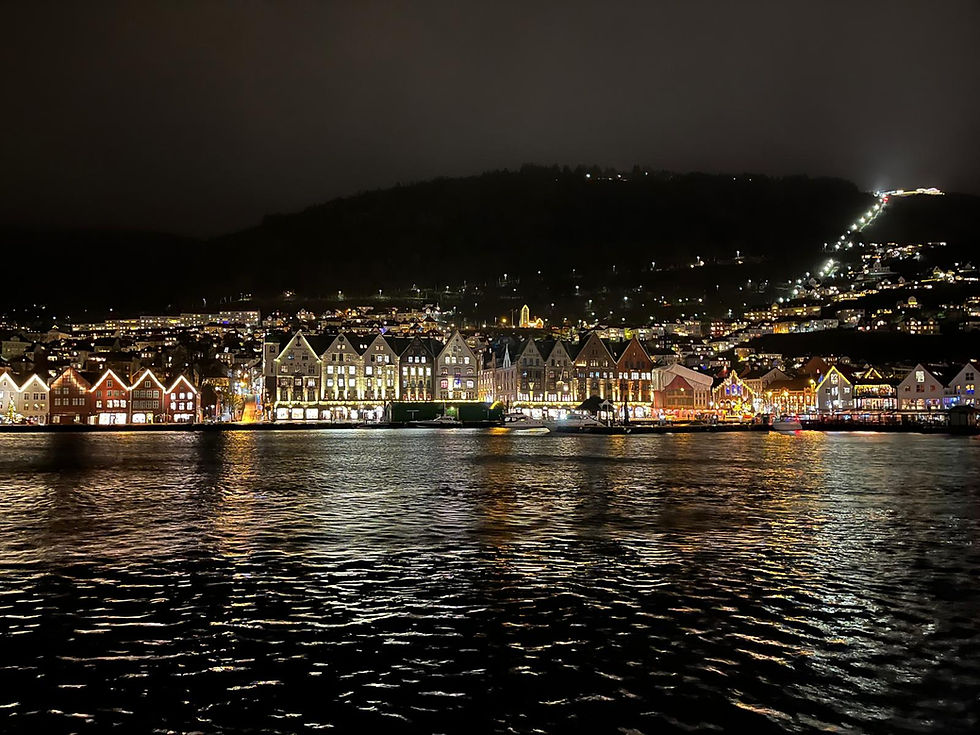Discovering Danish Delights
- YASS Secretary
- Dec 6, 2024
- 4 min read
In November YASS Vice Chair, Beck Sinar, visited Denmark for the first time to speak at a conference of Danish upper-secondary school teachers about northern identities in British popular culture. Here are some of her impressions from her short trip to Nyborg and Copenhagen.
The weather was frosty, with a few centimetres of snow in some places, but the welcome was very warm and friendly. Happy Danes and excited tourists mingled in the Copenhagen streets which were beautifully decorated with red hearts contrasted with deep green garlands marking the start of the festive season. Small wooden huts made up temporary Christmas markets in several locations, each selling locally made glass and wooden ornaments, woollen goods and all kinds of confectionery, as the sweet smell of gløgg, a kind of hot mulled wine, and pølser (sausages) cooking over open fires filled the air. There was no shortage of options when it came to food; Copenhagen truly is a culinary delight with everything from traditional Danish options to world-class global cuisines. YASS members had told me to head to a bakery early in the morning for fresh bread and pastries - and they were absolutely right. The smell was amazing; amongst the many options kanelsnegl ‘cinnamon snails’ and frøsnapper ‘seed snappers’ caught my attention for their fabulous names. Smørrebrød, a kind of open-faced sandwich of rye bread with various options for toppings were everywhere, but my favourite might have been the stegt flæsk, a kind of crispy pork (sorry vegetarians and vegans!).

(Look carefully and you might spot that even Santa Claus attended this Christmas market)
At Kongens Nytorv (The King's New Square), the statue of Christian V (King of Denmark and Norway 1670 - 1699) atop a horse watched on, as people wandered on the cobbles of Copenhagen’s largest public square. Copenhagen appeared to have many open spaces, many of which were green (or white with frost early in the day), adding to a relaxed feel to this northern capital. Excited children and adults whizzed around a temporary 2,200 square metre ice rink constructed around Krinsen (from the Danish word krans meaning ‘circle’ or ‘wreath’) which is in the middle of the square. Whilst I didn’t skate (even Bambi’s legs are more controlled on ice than mine!), I enjoyed watching others for a few moments, meeting some people from West Bromwich in the English Midlands near to where I grew up, as I did so (small world!).

The square is flanked by the Charlottenborg Palace (1671 - now the Royal Danish Academy of Fine Arts), the Thott Palace (1683 - now the French Embassy), the Royal Danish Theater (1874), the Hotel D'Angleterre and the Magasin du Nord department stores, all fine examples of Copenhagen’s different architecture, which seamlessly mixes the old with the new.
Nearby is the famous Nyhavn (new harbour), Copenhagen’s 17th-century waterfront, canal and entertainment district. It was constructed by King Christian V (the guy on the horse at Kongens Nytorv) from 1670 to 1675 and dug by Danish soldiers and Swedish prisoners of war from the Dano-Swedish War 1658–1660.

The southern side of Nyhavn has lavish mansions lining the canal, whilst the sunnier northern side is lined by brightly coloured townhouses built with wood, bricks, and plaster. The oldest house, at No. 9, dates from 1681. Many are now bars, cafes, and restaurants, each with outside seating, open fires and cosy blankets. Whilst at 8am Nyhavn was peaceful with only a handful of tourists like me taking photos and selfies, by 10.30am it was bustling with shoppers, tour groups heading for canal tours and sensible folk sat with warm drinks by those open fires!
Much of my time in Nyborg was spent at the conference venue, so that I sadly did not see Nyborg Slot (NYborg Castle), a royal castle built towards the end of the 12th century and nor did I see the Vor Frue Kirke (Nyborg church of our lady) built in the late 13th century. However, I did find out that Nyborg (new castle) is in central Denmark, located on the island of Funen, with a population of almost 18 thousand. As the easternmost settlement on Funen, it lies on the coast with a beautiful beach, from which you get a stunning view of Storebæltsbroen ‘The great belt bridge’. This is a magnificent piece of engineering but also an important part of the infrastructure allowing easy, quick and straightforward travel between Copenhagen and Central Denmark. The bridge is a multi-element fixed link crossing consisting of a road suspension bridge and a railway tunnel and a box-girder bridge for both road and rail traffic. It spans an impressive 11 miles and opened in 1997 to rail traffic and 1998 to road traffic.
At 7.30am when this photo was taken, looking from the beach across to the bridge, the sand of the beach was frozen solid; that did not, however, stop the bravest of Danes from rushing into the water for an early morning swim! Sadly, I didn’t have my swimming costume: next time, perhaps. I hope next time will be soon.

Written by Beck Sinar



